Yellow ladybugs are seen around the world. They live in Asia, Oceania, and North America. These bugs are often received with joy, many due to their looks.
Just like Ladybirds, yellow ladybugs come with black spots or black marks. They have the same dome-shaped body and they can fly similarly to Ladybirds.
Yellow ladybugs are either known for eating either other bugs or a range of flowers, mainly from agricultural fields.
Despite their potentially harmful effect on agriculture, these bugs are perceived as lucky by those who see them in many parts of the world. Their spiritual meaning is often different from their impact on these crops.
Table of Contents
Why Are Some Ladybugs Yellow?
Ladybugs come in different colors. From yellow, to red or even orange or amber, these joyful bugs are known to have different colors.
Many yellow ladybugs are known to develop black spots on their bodies as well. These are often quantified as they’re always the same number of spots.
The number of black spots on yellow ladybugs often inspires their name, such as in the case of the Fourteen-spotted Lady Beetle or the 22-Spot Ladybird.
Ladybugs are known to fully develop their color as they get out of the pupa. They might be pale yellow at first but their final yellow color shade settles within days.
Yellow ladybugs are also known to have small coloring shade differences depending on their genus. Males might be brighter or darker yellow compared to females.
For example, the male Giant Bamboo Ladybird is known to have a richer yellow color similar to gold compared to the pale-yellow color of the female Giant Bamboo Ladybird.
Types of Yellow Ladybugs
1. Fourteen-spotted Lady Beetle

The Fourteen-spotted Lady Beetle (Propylea quatuordecimpunctata) is known to be yellow but it also comes in multiple other colors. The constant in all the colors in its identity is the fourteen spots on its body.
These aren’t round spots as all of them are rectangular.
One of the most difficult tasks in identifying these types of bugs is correctly counting their spots as they aren’t separated. The spots on the Fourteen-spotted Lady Beetle are joined.
Fourteen-spotted Lady Beetles aren’t native to North America. They have been introduced to the US to control aphid populations.
Fourteen-spotted Lady Beetles are known to eat Russian wheat-eating aphids.
This species might have been introduced to control aphids but it also eats other insects. These ladybugs have been shown to even eat the eggs of other ladybugs.
2. 22-Spot Ladybug

This type of yellow ladybug (Psyllobora vigintiduopunctata) is common in the US. Native to Europe, it’s one of the few yellow ladybirds that don’t eat aphids.
The 22-spot ladybird eats mildew.
Ladybirds of this genus are identified by the number of black spots on their body as well as by their yellow coloring.
22 round spots aren’t joined distinguished on the elytra and the pronotum of these ladybugs.
This species is known to hide in dense vegetation.
It feeds on the mildew (a type of fungus) found in various types of vegetation.
3. Squash Lady Beetle
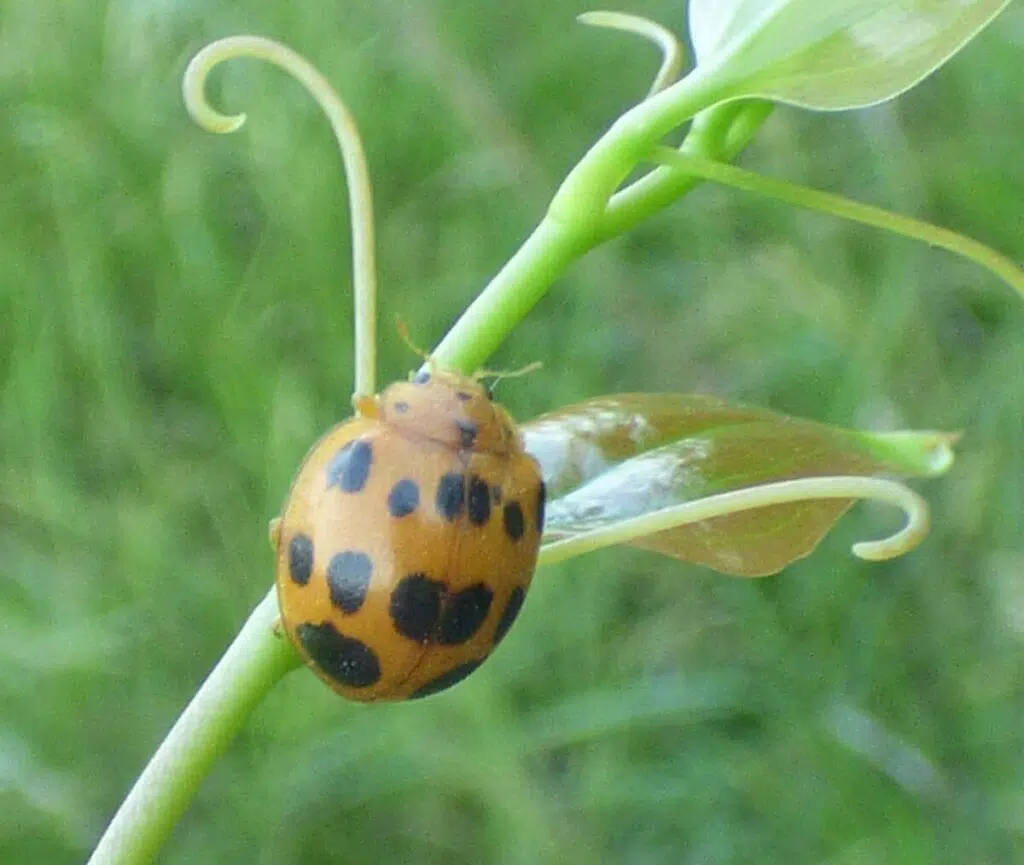
The Squash Lady Beetle (Epilachna borealis) is known for having an entirely yellow body with black spots. This type of ladybug is atypical and normally a sign of bad news for farmers.
As its name suggests, the Squash Lady Beetle feeds on plants from the squash family. This includes squash itself, as well as cucumbers and zucchini.
These ladybugs are known to only damage the flower and the leaves of squash and not the fruit itself. However, this may still halt squash growth.
As a result, farmers need to remove these ladybugs. This is normally done by hand.
The underside of leaves also needs to be checked as this is where these ladybugs lay eggs.
4. Fungus-eating Ladybird

As their name implies, these yellow ladybugs (Illeis galbula) are known for eating fungus of leaves.
But these ladybugs don’t eat all types of fungus. They only eat the fungus off cucurbits. This includes squash, zucchini, and cucumbers.
The fungus these bugs eats is harmful, but so are these ladybirds.
Identification of this species is based on an entirely-yellow body with joined black marks that make up almost half of its body.
5. Yellow Ladybird Beetle

This ladybird (Illeis koebelei) is partially yellow and partially white. It only has a few black spots on its pronotum.
But this spotless body is only specific to adult Yellow Ladybird Beetles. Their young have spots across the body.
Ladybirds of this genus are also known for eating mildew directly from plants.
6. Neda norrisi

Neda norrisi is a species of yellow ladybugs native to Northern South America. This species is partially yellow and partially black.
The species is known for also laying yellow eggs. These are always found on the underside of leaves adult yellow ladybugs consume for mildew.
7. Illeis confuse
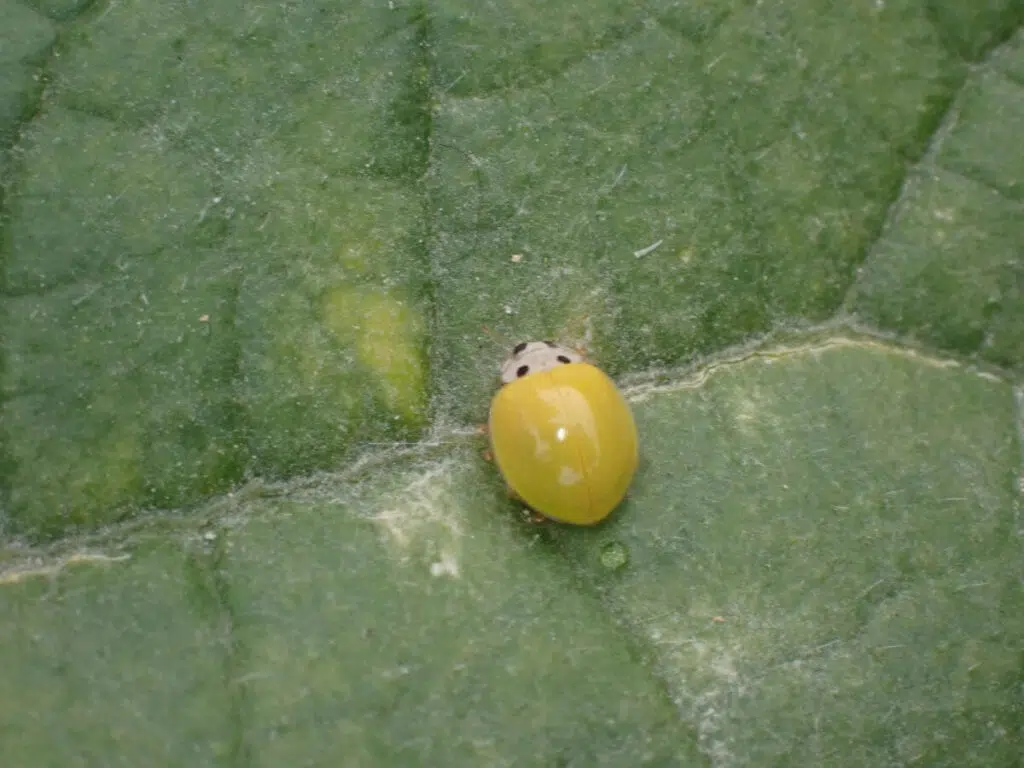
This species of ladybugs is almost entirely yellow. It only has a white pronotum with 3 black spots on it.
Part of the Coccinellidae family, these yellow ladybugs are also known for their worldwide distribution from the US to New Zealand.
Unlike many ladybugs, this species doesn’t eat insects. It simply eats mildew and plant leaves.
8. Variegated Fungus-eating Lady Beetle
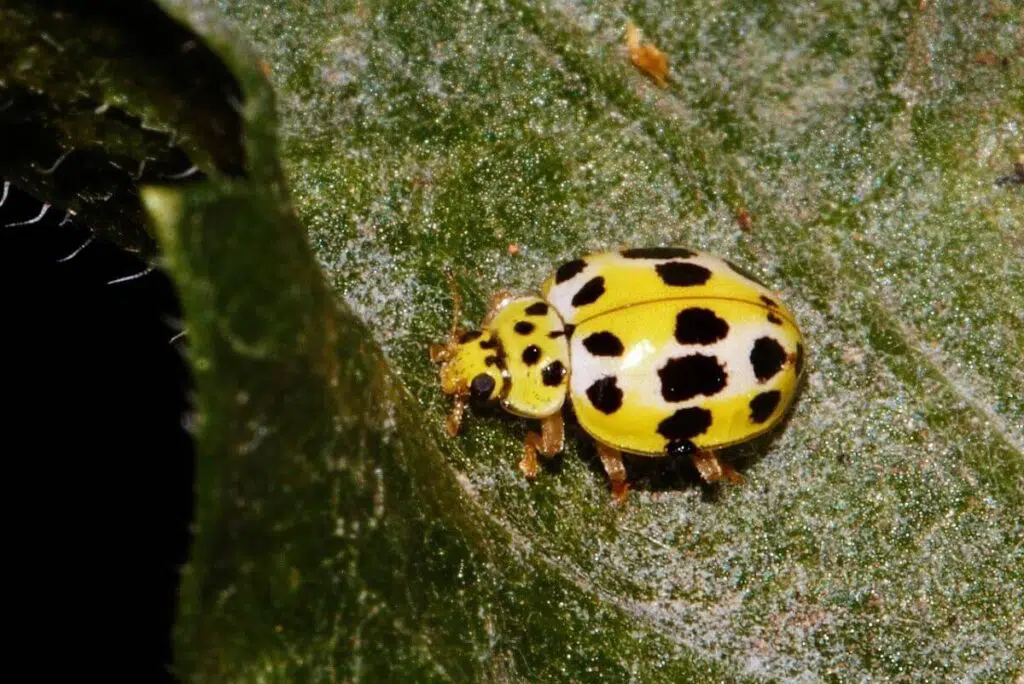
This ladybird (Psyllobora variegata) is seen in different colors. It comes in red and black color or yellow and black color.
Both these variations are met by just a few small black spots on the body.
As its name implies, this red or yellow ladybird is known for eating fungus.
9. Black-bordered Orange
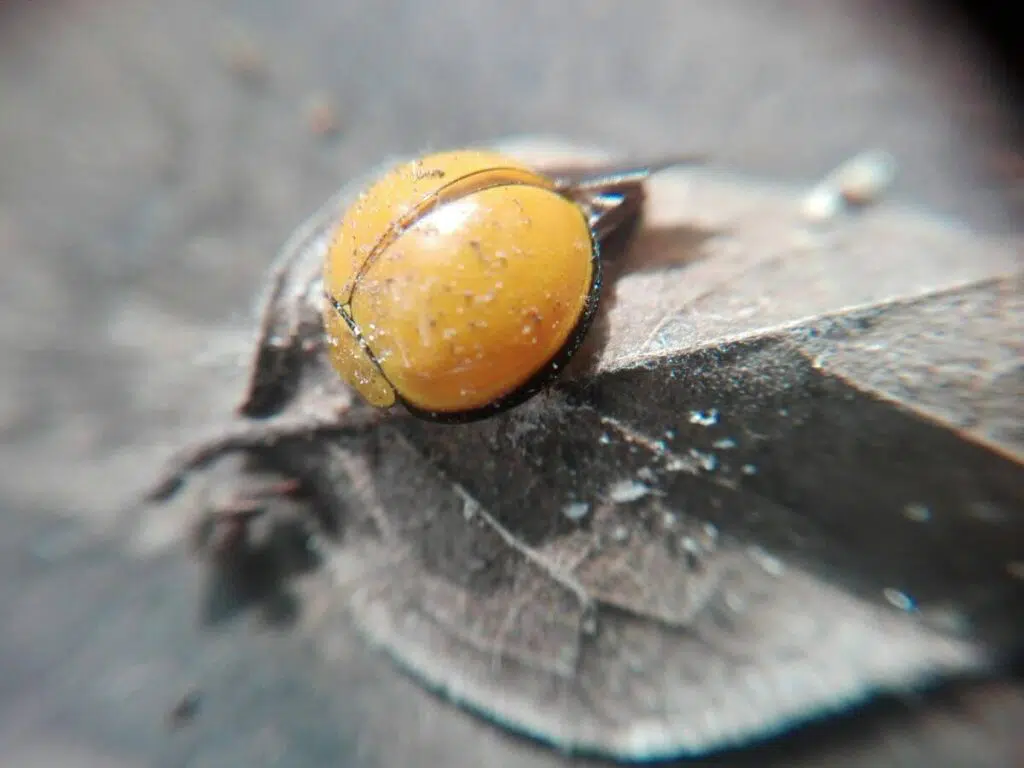
This species of ladybugs (Neda marginalis) gets its name from the Latin word ‘border’. It has a black-bordered body and a yellow to orange color.
Its true color varies depending on its environment. This species is known to be yellow on top and more orange or even amber towards the tip of the abdomen.
10. Megalocaria dilatata
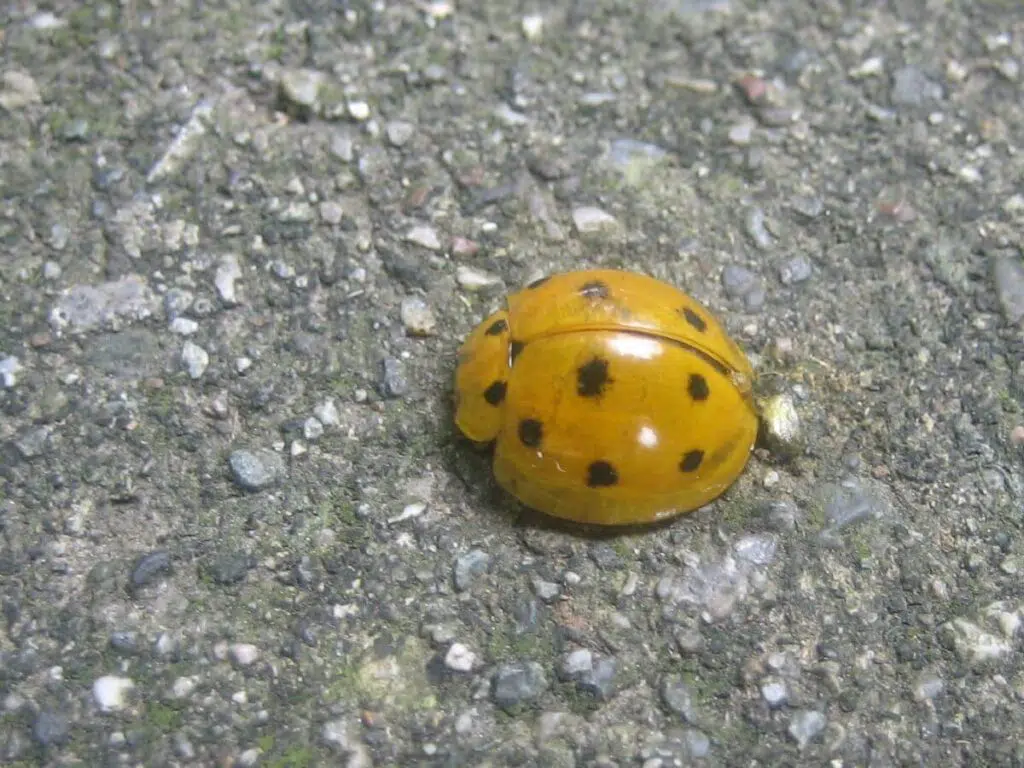
This is one of the smallest yellow ladybugs found in North America. The species is known to grow up to 2.8mm.
However, most ladybugs of this genus don’t measure more than 2.5mm.
Its coloring is a type of yellow with an orange undertone. This color is constant across all individuals of the species.
These are seen as invasive species in some parts of the world. Megalocaria dilatata is an invasive ladybug in sugarcane crops. The bugs also impact bamboo.
11. Giant Bamboo Ladybird

These ladybugs (Synonycha grandis) can be yellow or orange with black spots. They are common in Asia and Oceania. They are known as bug species that can begin mating soon after they emerge. They mate as soon as their second day of life laying eggs on the bottom side of leaves.
Males of this species are considered to be brighter and more vivid in yellow coloring. Their yellow color has been compared to the color of gold.
Yellow Lady Spiritual Meaning
As with all Ladybugs, yellow Ladybugs have a deep spiritual meaning. These dome-shaped bugs are associated with feelings of joy around the world.
While they can be detrimental to crops and farmers, these bugs are perceived as positive. Even a dead yellow Ladybug can be a positive sign with the right attitude.
Happiness
Yellow Ladybugs are associated with feelings of happiness around the world. Yellow is the symbol of happiness in countries like Australia where sports players are often dressed in yellow for good luck.
Flags around the world often include the yellow color as a good luck charm and to symbolize summer and happiness. Yellow Ladybugs have a similar positive image.
The color yellow makes many bugs look happier or it associates them with the feeling of happiness and well-being.
Positivity
Positivity should always be associated with yellow Ladybugs. Even the hardest times are often tied to the most positive spin to a problem when seeing these bugs.
Yellow is tied to happiness and youthfulness. It has a spirit of grabbing attention, but positively.
The joyful coloring of these bugs is tied to the color yellow. Their black markings are small compared to the percentage of the body that’s yellow in most species.
Prosperity
Wealth and prosperity are associated with a yellow Ladybug landing on yourself. You can expect to win a prize or to earn more at a job whenever one of these ladybugs lands on you according to some cultures.
Prosperity is often associated with gold. The yellow color of these bugs is the closest gold color a bug can have. Furthermore, some yellow Ladybugs are known for having a golden color rather than a yellow color.
Newly-weds good luck
Newly-weds are often associated with yellow Ladybugs. These are the bugs that are often sought after by those who want to get married.
Some cultures around the world say yellow Ladybugs can predict which person is about to get married. This is further represented by the bug landing on that person.
Does dreaming about ladybugs have any meaning?
Dreaming about yellow ladybugs has more meaning than seeing one in real life. Since these bugs might be rare in real life dreaming about them might be a more feasible event.
Not all ladybug dreams mean the same thing. Dreams and symbolism are interpreted depending on what the particular yellow Ladybug does in it more than its simple presence.
A dead ladybug in a dream signals rebirth
Surprisingly, a dead ladybug isn’t a sign you’re about to die. It’s a sign of rebirth.
A dead ladybug is one of the main indicators of new beginnings
The dream might mean you’re about to embark on a new path but it may also mean you get to meet new people, tie new relationships, or set new goals for yourself.
Dead yellow ladybugs in a dream might also mean you get to move. New beginnings are often tied to moving to a different location.
Catching Ladybugs in dreams means solving problems
You’re about to solve some type of problem whenever you catch a yellow Ladybug in a dream. Catching a bug that’s hard to catch means you solve a problem that’s difficult to solve.
This type of interpretation might mean fixing personal relationships as it may as well mean solving a professional issue.
Killing a ladybug in a dream means you’re working on yourself
You might dream that you kill a yellow Ladybug. This is the time you have to work on yourself.
A flying ladybird in a dream might mean you’re anxious about separation from your partner
Too many yellow Ladybugs in a dream means you have to put yourself first
A Ladybug flying toward you in a dream can come with fortunes
Ladybugs can fly away from you or towards you in a dream. The difference is considerable.
When the bug flies away it can mean the end of the beginning of a romantic relationship is coming.
When the bug flies towards you there are high chances of getting something valuable soon.
Do Yellow Ladybugs Bite?
Yellow Ladybugs are known to bite. These bugs might be small but they use biting or pinching as a means to catch soft prey or to bite through flowers.
Cases of yellow Ladybug bites aren’t easily found. These bites are often overlooked as humans barely sense them.
Many people can associate ladybug bites with the symptoms of a mosquito bite when seeing skin irritation. But the bite itself cannot be painful or even a true bite due to the following reasons.
They don’t have large mandibles
While yellow Ladybugs can bite, they don’t cause much harm to humans. Without large mandibles, these are just the bugs that can inflict almost no pain with their bite.
They can only eat soft-bodied insects
Yellow ladybugs sometimes eat soft aphids. They cannot eat bugs known for their hard exoskeletons such as cockroaches or spiders.
Yellow ladybugs also eat soft mildew
Most yellow ladybugs eat even softer foods such as mildew. This is a type of fungus found on certain leaves and flowers. Without the capacity to eat hard foods, Ladybugs cannot inflict a truly painful bite.
No poisonous saliva
Yellow ladybugs don’t have venom or poison. They don’t even have poisonous saliva like other types of bugs. This is why their bite is likely harmless to humans or animals.
A pinch is more likely
A bite is not exactly what these bugs are known for since they cannot pierce human skin. A pinch is more likely as it can sometimes grab onto the skin without truly perforating it.
Skin marks are likely
A yellow Ladybug pinch is likely to leave some type of skin marks. Some of these pinches aren’t even felt by humans as they aren’t impactful. Skin redness that subsides within a few hours is likely with a pinch from these bugs.
Yellow Ladybugs rarely bite, even when they make it indoors. Many people find these types of bugs can be handled easily without pinching.
Most yellow Ladybugs prefer to run away, however. These small bugs are generally fearful when seeing humans. This is why they might not be as easy to catch as other bugs that make it indoors, such as cockroaches.
Yellow Ladybugs can fly as well. This means these bugs can easily escape whenever you try to catch them.
Are Yellow Ladybugs Poisonous?
Yellow ladybugs aren’t a matter of concern for people. These bugs aren’t poisonous.
They don’t carry any type of disease. Yellow ladybugs aren’t known for drawing blood from animals either.
These bugs might be eating mildew but they don’t pose a poisonous threat to people.
What Do Yellow Ladybugs Eat?
Yellow Ladybugs are known for having a very specific diet. They either eat bugs such as aphids or fungus such as mildew.
Like many types of Ladybugs, these small crawlers can exclusively feed on a type of food. This is why they are only found in scattered locations around the world.
- Aphids
Aphids are some of the most problematic insects for farmers as they eat plants, flowers, and flowering vegetables. These soft insects are known for rapid multiplication.
Some types of yellow Ladybugs are known to eat aphids. These yellow bugs have even been introduced in certain areas of the world to control considerable aphid spread.
- Mildew
Mildew is a type of fungus that grows on plants, sometimes on crops. Yellow Ladybugs are known to eat mildew and they do so from the first day they’re alive.
How to Get Rid of Yellow Ladybugs
Getting rid of yellow Ladybugs can be just as complicated as getting rid of other types of bugs in the house.
While these bugs aren’t pests, they can still invade a home given the opportunity.
An open window or a temperature change might prompt one or multiple Ladybugs to get inside the house.
Homes on farms are more likely to see these bugs inside as they might be interested in aphids on nearby crops.
Eliminating these bugs from the house doesn’t require insecticide use.
Sweep and vacuum
Sweeping and vacuuming are generally sufficient to get rid of yellow Ladybugs inside the house.
A powerful vacuum cleaner is needed to quickly catch and trap these small bugs.
Eggs of these bugs might not be found inside the house. They prefer to lay eggs under leaves.
This is why these bugs are out of the house once vacuumed.
Pro tip: you should always seal the paper bag in the vacuum cleaner after removing it and dumping it in the trash can. Ladybugs don’t die by vacuuming and they might still escape and fly back into the house otherwise.
Plant mums
Some flowers are known to naturally repel yellow Ladybugs. Lavender is among them.
But most people use mums against Ladybugs. These colorful flowers are known to keep the bugs away.
Mums are available in orange, yellow, white, red, and many other colors. They can enhance the look of a house and also keep yellow Ladybugs away.

Seal wall cracks and openings
Some yellow Ladybugs are as small as 2.5mm. This means they can easily make their way indoors, especially at night when they might be attracted to light inside the house.
Since these bugs are so small it’s best to check for all possible cracks in walls and around windows.
Looking at the spaces they can crawl through around doors is also important.
Install window screens
Window screens might be needed to keep these bugs out. For many homes, these are not negotiable.
Homes near agricultural fields should all have these types of window screens.
While yellow Ladybugs don’t carry diseases, they might still be unpleasant to deal with when inside the house.
Use gloves and other essential oils
Cloves around the house and on the patio are known to keep yellow Ladybugs away.
Pure cloves and cloves essential oils are among the forms you can use to keep these bugs away.
Lavender essential oil as well as cypress essential oils are also known to keep Ladybugs away.
It’s best to find the right combination of essential oils to spray on the outer side of the house as well as indoors as bugs don’t like their pungent aromas.
Essential oils are also safer compared to the use of insecticide, especially indoors.
Yellow Ladybugs don’t have the same impact as cockroaches and other invasive bugs. They don’t need to be repelled with potentially harmful chemicals.
Summary
Yellow Ladybugs are known to be associated with happiness and prosperity. They are also associated with relationships and wealth.
Above all, these bugs are known to be beneficial to farmers in the US, especially when it comes to control aphids.
Yellow Ladybugs have been imported to the US from various parts around the world to control how aphids on crops.
Other types of yellow Ladybugs aren’t as beneficial as they’re known to eat fungus off cucurbits such as squash.
However, their impact is variable as they don’t eat the fruit of various cucurbits. These bugs have a friendly identity through their yellow (sometimes spotted) coloring. They have a deeper spiritual significance compared to other bugs.
Further Reading: